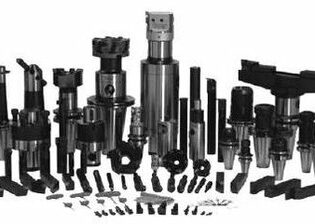What does 7:24 in BT toolholder mean? What are BT, NT, JT, it, cat standards? Nowadays, CNC machine tools are widely used in factories. These machines and tools come from all over the world, with different models and standards. Today, I’d like to talk about the tool holder of machining center.
The toolholder is the connecting body between the machine tool and the cutter. The toolholder is a key link affecting the concentricity and dynamic balance. It must not be treated as a general component. The concentricity can determine whether the cutting amount of each cutting edge is uniform when the tool rotates for one cycle, and the dynamic unbalance will produce periodic vibration when the spindle rotates.
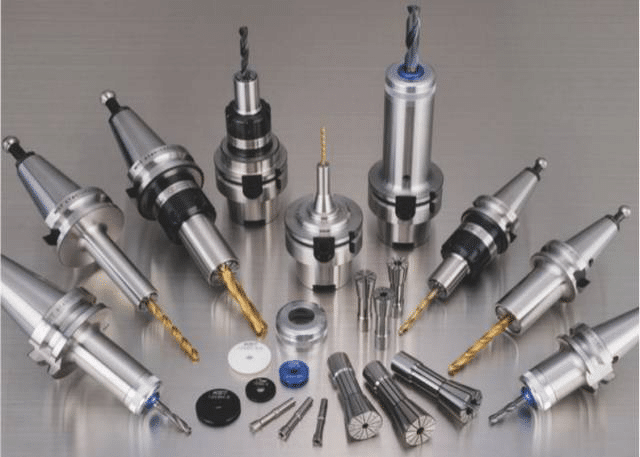
According to the spindle taper hole is divided into two categories
According to the taper of the tool hole installed on the spindle of the machining center, it is generally divided into two categories
Sk universal toolholder with taper of 7:24
HSK vacuum toolholder with taper of 1:10
Sk universal toolholder with taper of 7:24
7: 24 means that the taper of the toolholder is 7:24, which is a separate cone positioning, and the taper handle is longer. The cone surface plays two important roles at the same time, that is, the accurate positioning of the toolholder relative to the spindle and the realization of the toolholder clamping.
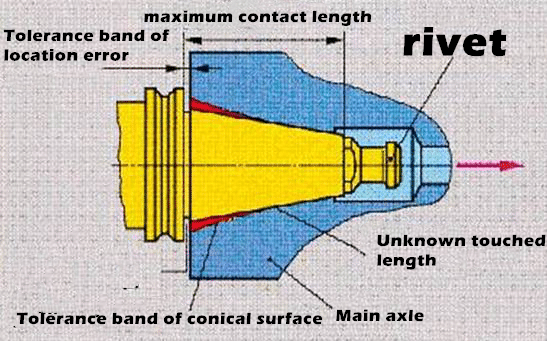
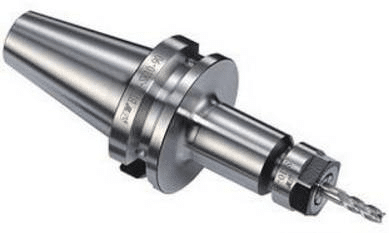
advantage:
Without self-locking, the tool can be loaded and unloaded quickly; as long as the taper angle is machined to high precision, the connection accuracy can be ensured, so the cost of tool holder is relatively low.
Disadvantages:
When the spindle rotates at high speed, the taper hole at the front end of the spindle will expand. The expansion increases with the increase of the rotation radius and rotation speed, and the taper connection stiffness will decrease. Under the pull force of the pull rod, the axial displacement of the toolholder will also change. After each tool change, the radial dimension of the toolholder will change, and the repeated positioning accuracy is unstable.
There are usually five standards and specifications for universal toolholder with taper of 7:24
1. International standard IS0 7388 / 1 (IV or it for short)
2. Japanese standard MAS BT (referred to as BT)
3. German standard DIN 2080 (NT or ST for short)
4. American Standard ANSI / ASME (cat for short)
5. DIN 69871 (JT, DIN, dat or DV for short)
Tension mode:
NT type toolholder is used to tighten the toolholder on the traditional machine tool through the pull rod, which is also known as st in China; the other four types of toolholder are tightened on the machining center by pulling nails at the end of the toolholder.
generality:
1) At present, DIN 69871 (JT) and MAS BT (Japan) are the most widely used tool holders in China.
2) The tool holder of DIN 69871 can also be installed on the machine tool of ANSI / ASME spindle taper hole;
3) The tool holder of is07388 / 1 can also be installed on the machine tools of DIN 69871 and ANSI / ASME spindle taper hole, so in terms of universality, the tool holder of is07388 / 1 is the best.
HSK vacuum toolholder with taper of 1:10
The elastic deformation of HSK vacuum toolholder not only contacts the 1:10 conical surface of the toolholder with the 1:10 conical surface of the spindle hole of the machine tool, but also makes the flange surface of the toolholder closely contact with the spindle surface. This double-sided contact system is superior to the 7:24 universal toolholder in high-speed machining, connection rigidity and coincidence accuracy.
HSK vacuum toolholder can improve the rigidity and stability of the system as well as the product precision in high-speed machining, and shorten the time of tool replacement. It plays an important role in high-speed machining. It adapts to the spindle speed of 60000 rpm. HSK tool system is widely used in aerospace, automobile, precision mold and other manufacturing industries.
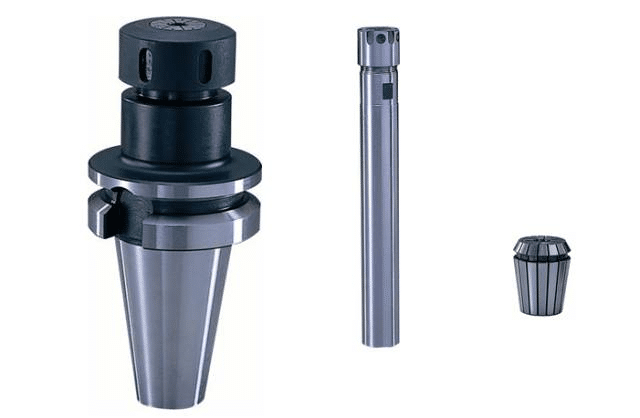
HSK toolholder has a type, B type, C type, D type, E type, F type and other specifications, of which a type, E type and F type are commonly used in machining center (automatic tool change).
The biggest difference between type A and type E:
- Type A has drive groove, while type E has no. Therefore, the A-type transmission torque is relatively large and can be used for some heavy cutting. However, the torque transmitted by the E-type is relatively small and can only be used for some light cutting.
2. In addition to the drive groove on the A-type toolholder, there are also manual fixing holes and directional grooves, so the balance is relatively poor. However, E-type is not, so E-type is more suitable for high-speed machining. The mechanism of type E and type F are identical. The difference between them is that the taper of type E and type F toolholders (e.g. E63 and f63) is the same as that of type E and type F. the taper of type F toolholder should be smaller by one size. That is to say, the flange diameters of E63 and f63 are both φ 63, but the cone size of f63 is only the same as that of E50. Therefore, compared with E63, the speed of f63 is faster (small spindle bearing).
2、 The mounting form of the handle
Spring collet handle
It is mainly used for clamping straight shank cutting tools and tools such as drill bit, milling cutter, tap, etc. the elastic deformation of clip spring is 1 mm, and the clamping range is 0.5 ~ 32 mm in diameter.
Hydraulic chuck
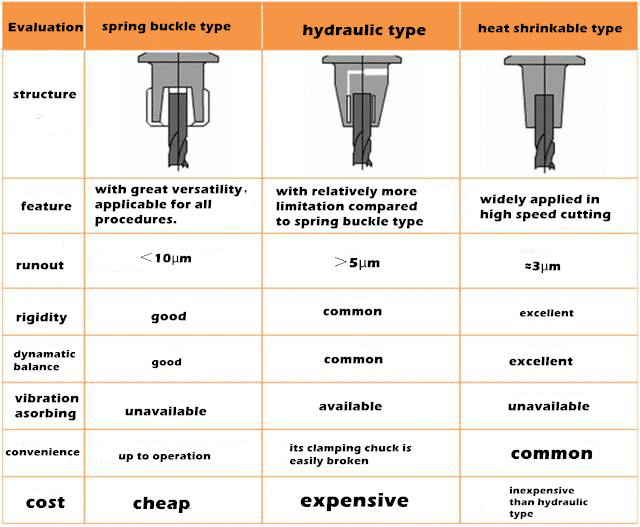
A-lock screw, use the hexagon wrench to tighten the locking screw; management
B-lock the piston and press the hydraulic medium into the expansion chamber;
C-expansion chamber, pressure produced by liquid extrusion;
D-thin expansion bushing can make the center of tool clamping rod locate and envelop evenly during locking process.
E-special seals ensure ideal sealing and long service life.
The tool holder is heated by induction heating technology, so that the diameter of the tool holder will expand, and then the cold tool holder is put into the hot toolholder. The heating toolholder has large clamping force and good dynamic balance, which is suitable for high-speed machining. The accuracy of repeated positioning is high, generally within 2 μ m, radial runout within 5 μ m, good anti fouling ability and anti-interference ability in machining. However, each type of toolholder is only suitable for the installation of a tool with one handle diameter, and a set of heating equipment is required.
Clamping principle of heat shrinkable toolholder:
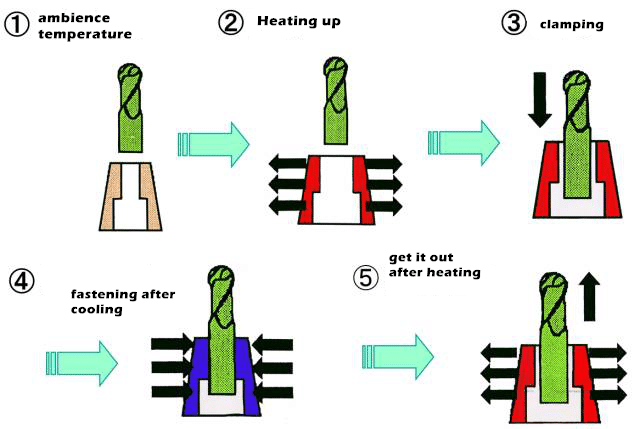
Tool handle comprehensive evaluation and comparison
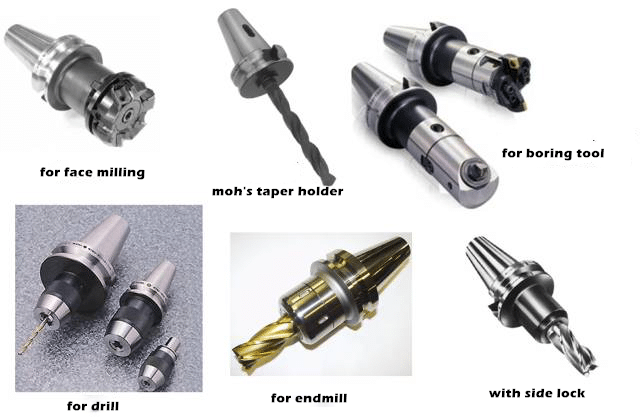
其
